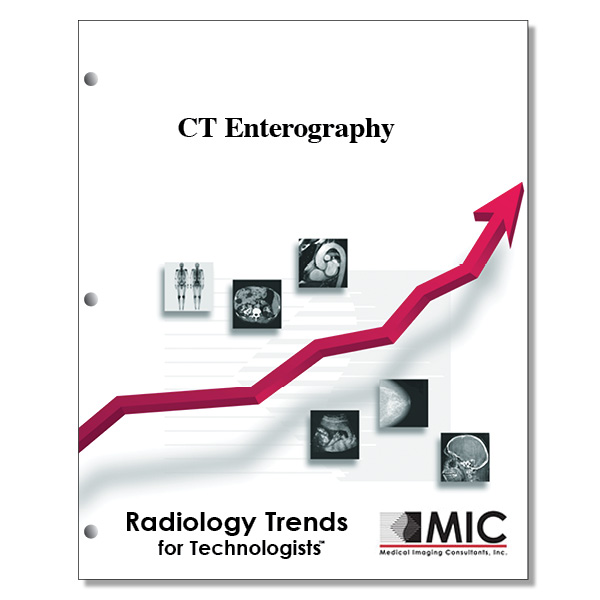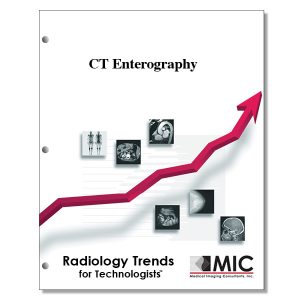

CT Enterography
An overview of CT enterography as an emerging alternative to traditional fluoroscopy for assessing small bowel disorders.
Course ID: Q00300 Category: Radiology Trends for Technologists Modalities: CT, Nuclear Medicine, Radiography2.25 |
Satisfaction Guarantee |
$24.00
- Targeted CE
- Outline
- Objectives
Targeted CE per ARRT’s Discipline, Category, and Subcategory classification for enrollments starting after February 8, 2023:
[Note: Discipline-specific Targeted CE credits may be less than the total Category A credits approved for this course.]
Computed Tomography: 2.25
Procedures: 2.25
Abdomen and Pelvis: 2.25
Magnetic Resonance Imaging: 1.50
Patient Care: 0.25
Patient Interactions and Management: 0.25
Procedures: 1.25
Body: 1.25
Nuclear Medicine Technology: 1.50
Patient Care: 0.25
Patient Interactions and Management: 0.25
Procedures: 1.25
Endocrine and Oncology Procedures: 0.25
Gastrointestinal and Genitourinary Procedures: 1.00
Radiography: 0.50
Patient Care: 0.25
Patient Interactions and Management: 0.25
Procedures: 0.25
Thorax and Abdomen Procedures: 0.25
Registered Radiologist Assistant: 2.25
Procedures: 2.25
Abdominal Section: 2.25
Sonography: 0.50
Patient Care: 0.25
Patient Interactions and Management: 0.25
Procedures: 0.25
Abdomen: 0.25
Radiation Therapy: 0.50
Patient Care: 0.25
Patient and Medical Record Management: 0.25
Procedures: 0.25
Treatment Sites and Tumors: 0.25
Outline
- Introduction
- CT Enterographic Technique
- Crohn Disease
- Ulcerative Colitis
- GI Tract Bleeding
- Small Bowel Neoplasms
- Celiac Disease
- Mesenteric Ischemia
- Other Findings
- Summary
Objectives
Upon completion of this course, students will:
- understand the benefits of capsule endoscopy over CT enterography
- be familiar with the advantages of CT enterography
- be familiar with the advantages and disadvantages of CT & MR enteroclysis
- recognize some of the disadvantages of CT enterography
- understand the patient preparation required for CT enterography
- learn how to improve visualization of mucosa and achieve better bowel distention
- learn proper contrast agent dose and timing for CT enterography
- know under what conditions to perform single vs. dual phase CT enterography
- recognize the indications for CT enterography
- learn the CT criteria that indicate active Crohn disease
- be familiar with the appearance of edematous bowel walls
- know what CT features are most indicative of Crohn disease
- be familiar with the signs that identify chronic, long term Crohn disease
- recognize some of the limitations of capsule endoscopy and when it should not be used
- know the modality of choice for imaging enteroenteric and enterovesical fistulas
- be able to identify a fistula on a CT image
- know what condition manifests as a continuous pattern of bowel wall involvement that starts from the rectum, without evidence of slip lesions
- know the term for ulcerative colitis that extends from the large bowel to include the terminal ileum
- understand colonoscopy’s role in the primary diagnostic stages of small bowel disease
- identify some of the characteristics of toxic megacolon
- recognize some of the causes of GI tract bleeding
- be familiar with the phases of the triple phase CT enterography technique
- identify the most common cause of occult GI bleeding
- be familiar with conditions which my lead to GI bleeding
- understand the limitations in early detection of small bowel neoplasms
- recognize the characteristics of benign GIST in the bowel
- recognize the characteristics of malignant GIST in the bowel
- recognize the characteristic of lymphoma when located in the small bowel
- know the condition which is a chronic inflammatory disorder of the small bowel induced in genetically susceptible people by the irritant gluten
- name the three most common causes of mesenteric ischemia
